Biography of Thomas Montagu 1st Count Perche 4th Earl Salisbury 1388-1428
Paternal Family Tree: Montagu
Maternal Family Tree: Maud Francis Countess of Salisbury 1364-1424
Before 13 Jun 1388 [his father] John Montagu 3rd Earl Salisbury (age 38) and [his mother] Maud Francis Countess of Salisbury (age 24) were married. He a great x 2 grandson of King Edward "Longshanks" I of England. 
On 13 Jun 1388 Thomas Montagu 1st Count Perche 4th Earl Salisbury was born to John Montagu 3rd Earl Salisbury (age 38) and Maud Francis Countess of Salisbury (age 24). He a great x 3 grandson of King Edward "Longshanks" I of England.
In 1389 [his grandfather] John Montagu 1st Baron Montagu, Baron Monthermer (age 59) died. His son [his father] John Montagu 3rd Earl Salisbury (age 39) succeeded 2nd Baron Montagu.
In 1395 [his grandmother] Margaret Monthermer Baroness Montagu 3rd Baroness Monthermer died. In 1395 Her son [his father] John Montagu 3rd Earl Salisbury (age 45) succeeded 4th Baron Monthermer. [his mother] Maud Francis Countess of Salisbury (age 31) by marriage Baroness Monthermer.

On 03 Jun 1397 William Montagu 2nd Earl Salisbury (age 68) died. His nephew [his father] John Montagu 3rd Earl Salisbury (age 47) succeeded 3rd Earl Salisbury, 5th Baron Montagu. [his mother] Maud Francis Countess of Salisbury (age 33) by marriage Countess Salisbury.
On 07 Jan 1400 at Cirencester, Gloucestershire [Map] Ralph Lumley 1st Baron Lumley (age 40) was beheaded by the townspeople following an unsuccessful attempt to seize the town. Baron Lumley forfeit.
Thomas Holland 1st Duke Surrey (age 26) was beheaded. He had to forfeit the honours and estates he had gained after the arrests of Gloucester and Arundel: Duke Surrey extinct. He retained those he had received before: His brother [his future brother-in-law] Edmund Holland 4th Earl Kent (age 16) succeeded 4th Earl Kent, 3rd Baron Holand, 8th Baron Wake of Liddell.
[his father] John Montagu 3rd Earl Salisbury (age 50) was captured, tried and beheaded. Earl Salisbury, Baron Montagu, Baron Montagu forfeit.
Bernard Brocas (age 46) was captured.
Before 1407 Thomas Montagu 1st Count Perche 4th Earl Salisbury (age 18) and Eleanor Holland (age 20) were married. She the daughter of Thomas Holland 2nd Earl Kent and Alice Fitzalan Countess Kent (age 56). He the son of John Montagu 3rd Earl Salisbury and Maud Francis Countess of Salisbury (age 42). They were half third cousin once removed. He a great x 3 grandson of King Edward "Longshanks" I of England. She a great x 2 granddaughter of King Edward "Longshanks" I of England. 


In 1407 [his daughter] Alice Montagu 5th Countess of Salisbury was born to Thomas Montagu 1st Count Perche 4th Earl Salisbury (age 18) and [his wife] Eleanor Holland (age 21). She a great x 3 granddaughter of King Edward "Longshanks" I of England.

After 1413 [his former wife] Eleanor Holland (age 27) died.
In 1414 Thomas Montagu 1st Count Perche 4th Earl Salisbury (age 25) was appointed 121st Knight of the Garter by King Henry V of England (age 27).

On 31 Jul 1415, when King Henry V of England (age 28) was in Portchester Castle, Hampshire [Map] preparing to invade France, Edmund Mortimer 5th Earl March 7th Earl Ulster (age 23) revealed the Southampton Plot to him. Henry Scrope 3rd Baron Scrope Masham (age 42), Thomas Grey of Werke and Heaton (age 30), and Richard of Conisbrough 1st Earl Cambridge (age 30) were intending to replace King Henry V of England (age 28) with Edmund Mortimer 5th Earl March 7th Earl Ulster (age 23) as King of England based on Edmund Mortimer 5th Earl March 7th Earl Ulster (age 23) having a better claim to the throne being descended from Edward III's second son Lionel Plantagenet 1st Duke of Clarence whereas King Henry V of England (age 28) was descended from the third son John of Gaunt 1st Duke Lancaster.





Robert Willoughby 6th Baron Willoughby (age 30), Richard de Vere 11th Earl of Oxford (age 29), Thomas Montagu 1st Count Perche 4th Earl Salisbury (age 27) and Thomas Camoys 1st Baron Camoys (age 64) sat in judgement.


On 25 Oct 1415 King Henry V of England (age 29) defeated the French army at the Battle of Agincourt. King Henry V of England (age 29) commanded the Main Battle. Thomas Camoys 1st Baron Camoys (age 64) commanded the Rearguard. 
Richard de Vere 11th Earl of Oxford (age 30) commanded. Humphrey Lancaster 1st Duke Gloucester (age 25) was wounded, and was protected by his brother King Henry V of England (age 29).

Edward York 2nd Duke of York 1st Duke Albemarle (age 42), commander of the Vanguard, was killed; the most senior English casualty. Duke Albemarle aka Aumale, Earl of Rutland and Earl Cork extinct. Richard Plantagenet 3rd Duke York (age 4) inherited his estates including Conisbrough Castle [Map].
John Fortescue (age 35), Dafydd Gam Brecon (age 35) and Edward Burnell (age 44) and Roger Vaughan of Bredwardine (age 38) were killed.


Michael de la Pole 3rd Earl Suffolk (age 21) was killed. His brother William "Jackanapes" de la Pole 1st Duke of Suffolk (age 19) succeeded 4th Earl Suffolk.
The English included: Louis Robbessart (age 25), Richard Beauchamp 13th Earl Warwick (age 33), William Botreaux 3rd Baron Botreaux (age 26), William Bourchier 1st Count Eu (age 41), John Cornwall 1st Baron Fanhope 1st Baron Milbroke (age 51), Edward Courtenay (age 30), Ralph Cromwell 3rd Baron Cromwell (age 12), Thomas Dutton (age 19), Edmund Ferrers 6th Baron Ferrers of Chartley (age 29), Roger Fiennes (age 31), Henry Fitzhugh 3rd Baron Fitzhugh (age 57), John Grey (age 28), John Grey 1st Earl Tankerville (age 31), William Harrington (age 42) as the King's Standard Bearer, Walter Hungerford 1st Baron Hungerford (age 37), Piers Legh (age 26) (wounded), Alfred Longford, Thomas Montagu 1st Count Perche 4th Earl Salisbury (age 27), Thomas Morley 6th Baron Marshal 5th Baron Morley (age 22), John Rodney, Richard Scrope 3rd Baron Scrope of Bolton (age 22), Robert Strelley (age 18), James Tuchet 5th Baron Audley, 2nd Baron Tuchet (age 17), Robert Umfraville (age 52), Thomas West 2nd Baron West (age 35), Robert Willoughby 6th Baron Willoughby (age 30). Thomas Erpingham (age 60) commanded the archers. Thomas Rempston (age 26) was present. Thomas Strickland (age 48) carried the Banner of St George.


















Thomas Tunstall (age 57) was killed.
The Welsh included: William ap Thomas "Blue Knight of Gwent" Herbert (age 35), Walter Sais (age 95), Roger Vaughan (age 70) and his son Roger Vaughan (age 5). Owen Tudor (age 15) is believed to have been present as a squire.

The French army suffered significant casualties. Charles Albret (age 46), Philip Valois II Count Nevers (age 26), John of Bar (age 35), Jacques Chatillon (age 48), David Rambures (age 51) and his three sons: Jean Rambures, Hugues Rambures, Philippe Rambures, Waleran Luxemburg (age 60) and Hector de Chartres were killed.

Charles Valois Duke Orléans (age 20) was captured by Richard Waller (age 20) for which he was knighted on the battlefield by King Henry V of England (age 29).

John Bourbon I Duke Bourbon (age 34) and Charles Artois Count Eu (age 21) were captured.
Robert of Bar Count Soissons Count Marle (age 25) was killed. His daughter Jeanne of Bar Countess Soissons succeeded Countess Soissons 1367.
Edward of Bar III Duke of Bar (age 38) was killed. His brother Cardinal Louis of Bar (age 38) succeeded I Duke Bar.
John Valois I Duke Alençon was killed. His son John Valois II Duke Alençon (age 6) succeeded II Duke Alençon.
Frederick Metz I Count Vaudémont (age 47) was killed. His son Antoine Count of Vaudémont (age 15) succeeded Count Vaudémont.
Anthony Valois Duke Brabant (age 31) was killed. His son John Valois IV Duke Brabant (age 12) succeeded IV Duke Brabant. Jacqueline Wittelsbach Duchess Brabant and Gloucester (age 14) by marriage Duchess Brabant.

Jean II Le Maingre "Boucicaut" (age 49) was captured.
Georges de La Trémoille (age 33) was captured.
Chronicle of Gregory 1403-1419. 01 Nov 1417. Ande that same yere the kyng (age 31) layde sege unto Faleys [Map] the fyrste day of Novembre, and that sege contynuyde unto the xx day of Decembre, the yere of grace Mlcccc xvij. Thenne the towne dysendyd for to trete whythe the kynge, and the kyng commyttyd the trety unto Thomas Erle of Saulysbury (age 29), and to Harry Lorde Fehewe, and to Syr Johnne Cornewale, and to Syr Wylliam Haryngdon (age 27), knyghtes and commyssyoners for hys partye; and as for the party of the towne, Syr Wylliam Molene (age 39)25, Syr Gylberte Mounstrewys, lorde of Fayete26, capytaynys of men of armys, and of the schotte whythe ynne the towne of Faleys, and whythe [them] 27 a pon the same trete, the lord of Gamulle;28 which29 parteys entretid30 ande a cordyd uppon the artyculys and poyntmentys aftyr folowyng.


Alle so hit ys accordyd that alle the strongers that benne in the fore sayde towne of Faleys, the whyche before thys tyme hathe ben founde agayne, and in the rystynge of, the kynge in tyme sythe hys fyrste comynge to hys Duche of Normandye, were hyt at Cane [Map], or in any othyr of furtheresser, or that have benn with the kynge, or with any of hys subgettys in hys commaundementys, that alle suche strangerys shulle put hem only in the kyngys grace and mercy of oure soverayne lorde the Kyng of Inglonde.
Fryste, that hit ys accordyd that the secunde day of Janyver next folowynge they shulde yelde uppe [th]e towne be-for sayde of Faleys, whythe ynne the houre of terce, into the hondys and power of oure soverayne lorde the kynge, or in to the hondys of hem be hym commyttyde and assygnyde, yf soo be that they be nott rescwyde be batayle of the kynge hyr lorde, or Dolfyn, hys eldyste sone, or by the Constabylle of Fraunce. And on that the kyng [to]31 setten or do settynne in the fore sayde towne suche32 warde and kepynge as hit schalle lyke hym.
Alle so hyt ys accordyd that they shalle delyvery and yeldyn uppe33 alle the presoners, Englysche or any othyr, holdyng of owre lege lorde the Kyng of Inglonde, the whiche that34 have benne presoners be fore35 the fyrste daye a fore sayde, ande at the same daye of thys present trete, and [that]36 non appechementt ben put up on none of hem by hyr maysterys nowe at that thys tyme [nor in tyme]37 to come, be hyt sommaunce38 requyrynge or askyng in any maner [matier]39 what soo evyr hyt be, but fynallye the for sayde maysterys shalle aquyntyn, renownsyn, and relessyn to hyr presoners hyr troughthys, hyr behestys, and hyre othysse, whyche that [the seid presoners mowen have made to heir maisters in eny maner, and that]37 whythe owte fraude or malyngyne.
Alle so hyt ys accordyd that the fore sayde capytaynys shulde delyvery owte of the towne of Faleys in to the hondys of the commyssenaryours of oure soverayne lorde the Kyng of Inglonde, al thoo that were borne in Inglonde, Walys, and Yrlonde, or Gascoyne, whiche be-fore thys tyme have holde whythe the party of Inglonde, and for thys presentt tyme ben in thys sayde towne of Faleys contrarye ayenste the kyng and hys parteyes.
Alle so hyt ys accordyd that non of the captaynys, nor burgessys, nor non othyr of the towne, shalle geve nor suffer for to be gevyn to hem of the castelle of Faleys any strengthe of men, of armys, or of schotte, nor maner of socoure of armyrowrysse or artury, schottys, powder, gonnys, or any othyr comfort durynge the for sayde trete.
Alle so hyt ys accordyd that noo captayne, ne none sowdyer, burgeys, ner comyner, nor non othyr beynge whythe ynne the sayde towne of Faleys, shalle ressayve or suffer to be ressayved or drawyn owte of the castelle the captayne of the same castelle nor non othyr of the same garysonne thereynne beynge at40 thys present tretys41. Ande alle soo they shulle nott drawe any42 of hem of the castelle undyr the coloure of thys presentt tretye.
Ande uppon thys our soverayne lorde the kynge of specyalle grace hathe grauntyd unto the forsayde captaynys, sowdyers, and othyr of the sayde towne, hyr horse, harneys, and alle hyr othyr goodys what evyr hyt be, owte-take artury, shotte, powders and gonnys, arblastrys, and bawderykys for arblastrys, whyche that shalle abyde stylle in the same towne, and alle wey for to sen that the straungers of whyche the seconde artycule makythe mensyon, nor shalle not emynucyon43 the pryvelegys and the benyfytys of thys presentt artyculys.
Alle the for sayde captaynys have sworne a-pon hyr honowre that durynge the for sayde trete that they shalle not makyn nor suffyr to be made any brekyng, wastynge, nor be putt nor done a waye any of suche artyculys, shotte, or any othyr thyng be-fore sayde.
Alle so hit ys accordyd that durynge the fore sayd trete noo maner of poyntment of the wallys of the towne shalle be made, but the wallys shalle be leve stylle lyke as they ben foundyn the fyrste daye of this present trete.
Alle so hyt hys accordyd that noo sowdyer nor stranger in the towne of Faleys shalle not make noo robory nor pylyage on the burgeysys of the towne of Faleys in noo maner, ande yf any suche evylle doers ben founde, that thenne the captaynys of men of armys and of shotte do ther on justyfyynge and execusion, or ellys that alle suche evylle doers shalle forfete hyre benyfys and hyr saffecondyte.
Alle so hyt [is] 44 accordyd that the sayde captaynys nor non othyr of the same towne shalle nought bere away, nor purlayne, nor suffer to ben i-purlaynyd or doo a-waye, any ornamentys, jewellys, or relyqwys of Hooly Chyrche, be they of the same towne or of any othyr relygyous owte of [th]e towne, that perchaunce were brought unto the towne for dowte of warre or othyr wyse i-brought unto the towne.
Alle so hit ys accordyde that the for sayde captaynys nor non othyr of hyr feleschyppe shalle nought ledyn nor bere, nor suffer for to be borne nor lede, owte of the townye of Faleys, noo maner of goodys undyr the colowre of appyontementt, but oonly hyr owne propyr goode.
Alle so hyt ys accordyd that alle the capitaynys whythe hem of alle hyr company shalle a-voyde the towne of Faleys the secunde day of Janyver abovyn sayde by the sonne goynge downe, but yf that they were rescwyd as hyt ys a-fore sayde. And oure soverayne lorde the Kynge of Inglond of hys specyalle grace hathe grauntyd to alle and to every burgeys of the towne of Faleys, that wylle dwelle and abyde stylle in the fore sayde towne, there to a-byde and dwelle, sykerly and surely and fully, whythe owte any enpechyment uppon hem to putte in body or in goodys, mevabylle or unmevabylle, as herytagys nor possessyons whythe ynne the fore sayde towne, but pessabylly rejoysynne as hyr propyr goodys at thys tyme and in tyme to come, as they myght done before the yelding upe of the same towne; be so alle way that they so wyllynge to dwelle and byde in the same towne be come legys and obedyaunte to oure soverayne lorde the Kyng of Inglonde and hys ayrys.
45 Alle so hyt ys accordyd that noo captayne, sowdyer, nor burgeys, nor comyner, nor non othyr whithe ynne the sayde towne of Faleys, shalle nought ressayvynne, nor suffer to ressayvynne, nor drawyn of the castelle of Faleys the captayne ther of, nor non of there garysons, nor non at thys tyme there abydynge [in] 46 the for sayde chastelle, nor noo maner of goodys to hem longyng undyr colowre and shadowe of goodys of the towne, nothyr undy[r] coloure of thys presente trete.
Alle so hyt ys accordyd that hangyng thys presentte trety and appoyntement noo maner of warre shalle be made by-twyne hem ande the oste of oure soverayne lorde the Kyng of Inglonde and hem of the towne of Faleys47.
Alle so hyt ys accordyd that the forsayde lordys and capytaynys of the towne of Faleys shalle take and delyvery xij of the jentyllyste knyghtys and squyers notablys in ostage, the whiche shalle be delyveryde a yenne at the daye that the forsayde lordys and capytaynys havyng fully hyr poyntys48. And for thys trete and appoyntment welle and trewly [to]49 ben holdyn on oure parte, the forsaide Thomas Erle of Salysbury, Harry Lorde Feehewe, John Cornewale and Wylliam Haryngdon, knyghtys, unto thys sedylle (id est a bylle) of poyntmentt have sette to oure selys for the grete50 affyrmacyon of trought. Gevynne be-fore the towne of Faleys, the xx day of the monythe of December and the yere a-fore sayde.
The whyche towne in maner and forme as hyt ys be-fore sayde was yoldynne to our soverayne lorde the kynge of Inglonde [th]e seconde daye of Janyver as hyt was before lemytyd, ande the castelle be lefte stylle un-y[o]ldon unto the fyrste daye of Fevyrer51; the whyche castelle was yoldynne the seconde daye of the monythe a-bove sayde, and delyveryd in maner and forme a-fore-sayde, &c.
Note 25. Molene. Melone in Vit. The name is Meulhou in Rymer.
Note 26. Fayete. Our MS. reads, lorde of feyfty capytaynys; but Vit. more accurately, "lord Fayete, capteyns."
Note 27. Omitted in MS.; J. reads "hem."
Note 28. the lord of Gamulle. This reading is taken from J. The name is written in the same way on Norman Roll, 5 Hen. V., m. 2, from which the treaty is printed in Rymer, and perhaps it may be read, as Rymer reads it, "Ganville." Our MS. reads absurdly, "they of Gaunte." Perhaps the person intended was the Sire de Graville, who a few months later (4 July, 1418) disputed with the English the passage of the Seine at Pont de l'Arche.-Williams's "Gesta Henrici V.," 122
Note 29. which. with, MS.
Note 30. entretid. encresyd, MS.; corrected from J.
Note 31. Supplied from J.
Note 32. suche. The MS. reads "whiche," an evident error, which is corrected from Vit.
Note 33. "the town and," V.
Note 34. that. there, V.; that there, J.
Note 35. be forerepeated in MS.
Note 36. Supplied from J.
Note 37. Omitted in MS.; supplied from J. and V.
Note 38. J. reads, "be it to sommone, requiren, or asken."
Note 39. Omitted in MS.; supplied from V.
Note 40. at. and, MS.; at, J.
Note 41. tretys. tyme, J.; trete tyme, V.
Note 42. any. J. reads, "eny goodes of them of the castel undre the colour and shadowe of her owne goodes of the towne, ne undre the colour of this present trete."
Note 43. emynucyon. enjoie, J. A blank is left for the word in V.
Note 44. Omitted in MS.
Note 45. This is a repetition of a former article which will be found in its right place on p. 118.
Note 46. Omitted in MS.; supplied from J.
Note 47. J. adds, "forseen alweys that it be understanden that the castel of Faloys, ne non theryn, be comprehendid ne taken in this present abstinence."
Note 48. havyng fully hyr poyntys. han fulfillid here promyse, J.
Note 49. Omitted in MS.; supplied from J.
Note 50. grete. gretter, J.
Note 51. J. gives also the text (translated) of the articles for the surrender of the castle, which are dated on the 1st Feb., and of which the two first are printed in Rymer, ix. 541, in the original French. See Appendix.
In 1419 Thomas Montagu 1st Count Perche 4th Earl Salisbury (age 30) was created 1st Count Perche.
In 1421 Thomas Montagu 1st Count Perche 4th Earl Salisbury (age 32) was restored 4th Earl Salisbury, 3rd Baron Montagu, 6th Baron Montagu, 5th Baron Monthermer although he had been styled Earl since 1409.
After 1421 Thomas Montagu 1st Count Perche 4th Earl Salisbury (age 32) and Alice Chaucer Duchess Suffolk (age 17) were married. She by marriage Countess Salisbury. He the son of John Montagu 3rd Earl Salisbury and Maud Francis Countess of Salisbury (age 57). He a great x 3 grandson of King Edward "Longshanks" I of England. 

Before 1423 [his son-in-law] Richard Neville Earl Salisbury (age 23) and [his daughter] Alice Montagu 5th Countess of Salisbury (age 15) were married. She the daughter of Thomas Montagu 1st Count Perche 4th Earl Salisbury (age 34) and Eleanor Holland. He the son of Ralph Neville 1st Earl of Westmoreland (age 58) and Joan Beaufort Countess of Westmoreland (age 43). They were half fourth cousins. He a great grandson of King Edward III of England. She a great x 3 granddaughter of King Edward "Longshanks" I of England. 



On 31 Jul 1423 the English and Burgundian army defeated the French and Scottish armies at the Battle of Cravant at Cravant, Yonne. On the English side Thomas Montagu 1st Count Perche 4th Earl Salisbury (age 35) commanded. Robert Willoughby 6th Baron Willoughby (age 38) was second in command.

The French and Scottish army were commanded by John Stewart of Darnley 1st Count Évreux (age 43). Louis Bourbon 1st Count Vendôme 1st Count Castres (age 47) was second in command. Both were captured; Darnley lost an eye.
On 30 Jul 1424 [his mother] Maud Francis Countess of Salisbury (age 60) died.
On 12 Oct 1428 the Siege of Orléans commenced at Orléans. During the course of the siege Thomas Montagu 1st Count Perche 4th Earl Salisbury (age 40) and Jean Poton Xaintrailles (age 38) were wounded. William "Jackanapes" de la Pole 1st Duke of Suffolk (age 31) commanded the English forces during some of the siege.

On 03 Nov 1428 Thomas Montagu 1st Count Perche 4th Earl Salisbury (age 40) died from wounds received at the Siege of Orléans. His daughter [his daughter] Alice Montagu 5th Countess of Salisbury (age 21) succeeded 5th Countess Salisbury, 4th Baroness Montagu, 7th Baroness Montagu, 6th Baroness Monthermer. [his son-in-law] Richard Neville Earl Salisbury (age 28) by marriage Earl Salisbury.
On 11 Nov 1430 William "Jackanapes" de la Pole 1st Duke of Suffolk (age 34) and [his former wife] Alice Chaucer Duchess Suffolk (age 26) were married. She by marriage Countess Suffolk. He the son of Michael de la Pole 2nd Earl Suffolk and Katherine Stafford Countess Suffolk. He a great x 4 grandson of King Edward "Longshanks" I of England. 


On 20 May 1475 [his former wife] Alice Chaucer Duchess Suffolk (age 71) died. She was buried at St Mary's Church, Ewelme [Map].
After 20 May 1475. St Mary's Church, Ewelme [Map]. Monument to [his former wife] Alice Chaucer Duchess Suffolk (deceased). Wrist Garter. The effigy was, apparently, viewed to determine how a lady should wear the garter at the re-commencement of Lady of the Garter appointments in 1901 after a gap of several hundred years. A particularly fine Cadaver Underneath the chest on which Alice's effigy lies. Full-length in a shroud. Chest with Angels with Rounded Wings holding Shields.
Detail of the South Side of the Monument to Alice Chaucer Duchess Suffolk (deceased).
1  Roet Arms impaled
Roet Arms impaled  Chaucer Modern Arms. Alice's paternal grandparents.
Chaucer Modern Arms. Alice's paternal grandparents.
2  De La Pole Arms impaled
De La Pole Arms impaled  Stafford Arms. Her third husbands parents Michael de la Pole 2nd Earl Suffolk and Katherine Stafford Countess Suffolk.
Stafford Arms. Her third husbands parents Michael de la Pole 2nd Earl Suffolk and Katherine Stafford Countess Suffolk.
3  Montacute and Monthermer Arms impaled Francis? Possibly Alice's second husband's parents [his father] John Montagu 3rd Earl Salisbury and [his mother] Maud Francis Countess of Salisbury.
Montacute and Monthermer Arms impaled Francis? Possibly Alice's second husband's parents [his father] John Montagu 3rd Earl Salisbury and [his mother] Maud Francis Countess of Salisbury.
4  De La Pole Arms quartered
De La Pole Arms quartered  Chaucer Modern Arms.
Chaucer Modern Arms.
5  Roet Arms quartered
Roet Arms quartered  Chaucer Modern Arms.
Chaucer Modern Arms.
8  De La Pole Arms impaled
De La Pole Arms impaled  England Henry IV Arms signifying Alice's son John's (age 32) marriage to Elizabeth of York (age 31) sister of King Edward IV of England (age 33).
England Henry IV Arms signifying Alice's son John's (age 32) marriage to Elizabeth of York (age 31) sister of King Edward IV of England (age 33).
Detail of the North Side of the monument to Alice Chaucer Duchess Suffolk (deceased). Arms from left to right ...
1  De La Pole Arms quartered
De La Pole Arms quartered  Chaucer Modern Arms impaled Unknown.
Chaucer Modern Arms impaled Unknown.
2  De La Pole Arms impaled
De La Pole Arms impaled  Chaucer Modern Arms. Her third husband William "Jackanapes" de la Pole 1st Duke of Suffolk.
Chaucer Modern Arms. Her third husband William "Jackanapes" de la Pole 1st Duke of Suffolk.
3  De La Pole Arms quarted
De La Pole Arms quarted  Chaucer Modern Arms. Alice's son John de la Pole 2nd Duke of Suffolk (age 32) by her second husband William "Jackanapes" de la Pole 1st Duke of Suffolk.
Chaucer Modern Arms. Alice's son John de la Pole 2nd Duke of Suffolk (age 32) by her second husband William "Jackanapes" de la Pole 1st Duke of Suffolk.
5  Montacute and Monthermer Arms quartering impaled Chaucer. Alice's second husband Thomas Montagu 1st Count Perche 4th Earl Salisbury.
Montacute and Monthermer Arms quartering impaled Chaucer. Alice's second husband Thomas Montagu 1st Count Perche 4th Earl Salisbury.
6  Roet Arms. Alice's paternal grandmother Philippa Roet.
Roet Arms. Alice's paternal grandmother Philippa Roet.
7  England Henry IV Arms impaling
England Henry IV Arms impaling  Roet Arms probably signifying John of Gaunt 1st Duke Lancaster and Katherine Roet Duchess Lancaster, Katherine being the sister of Alice's paternal grandmother Philippa Roet who married Geoffrey Chaucer.
Roet Arms probably signifying John of Gaunt 1st Duke Lancaster and Katherine Roet Duchess Lancaster, Katherine being the sister of Alice's paternal grandmother Philippa Roet who married Geoffrey Chaucer.
8  Roet Arms impaling
Roet Arms impaling  Chaucer Modern Arms. Her paternal grandparents Geoffrey Chaucer and Philippa Roet.
Chaucer Modern Arms. Her paternal grandparents Geoffrey Chaucer and Philippa Roet.
Katherine Stafford Countess Suffolk: Around 1376 she was born to Hugh Stafford 2nd Earl Stafford and Philippa Beauchamp Countess Stafford. She a great x 3 granddaughter of King Edward "Longshanks" I of England. Before 1394 Michael de la Pole 2nd Earl Suffolk and she were married. She by marriage Countess Suffolk. She the daughter of Hugh Stafford 2nd Earl Stafford and Philippa Beauchamp Countess Stafford. He the son of Michael de la Pole 1st Earl Suffolk and Katherine Wingfield Countess Suffolk. She a great x 3 granddaughter of King Edward "Longshanks" I of England. On 08 Apr 1419 Katherine Stafford Countess Suffolk died.
Philippa Roet: Around 1346 she was born to Giles "Payne" Roet. Before 1367 Geoffrey Chaucer and she were married at St Mary de Castro Leicester, Leicestershire. Excerpta Historica Page 152. Philippa, his eldest daughter, is stated to have been the maid of honour to Philippa Queen of Edward the Third who by the name of "Philippa Pycard" obtained a grant of one hundred shillings per annum on the 20th January 1370, and married Geoffrey Chaucer, to whom, in consequence, it is supposed, of this connexion, the Duke of Lancaster granted the Castle of Dodington. Of John of Gaunt's connexion with Chaucer, however, no proof has been found; and the circumstance of the lady assigned to him for his wife being styled "Philippa Pycard," instead of Roelt, renders the assertion, that she was the sister of the Duchess of Lancaster, extremely doubtful. Around 1387 Philippa Roet died.
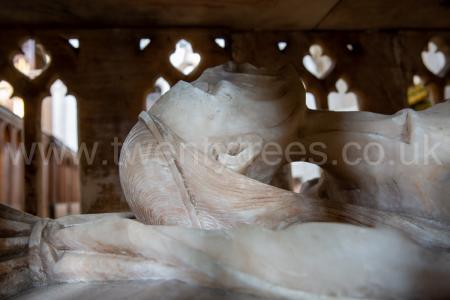
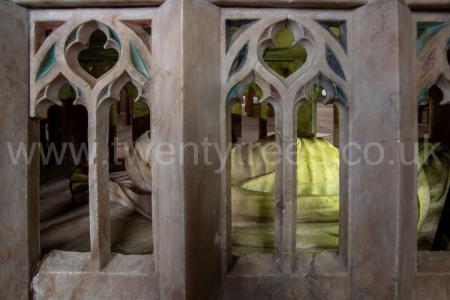
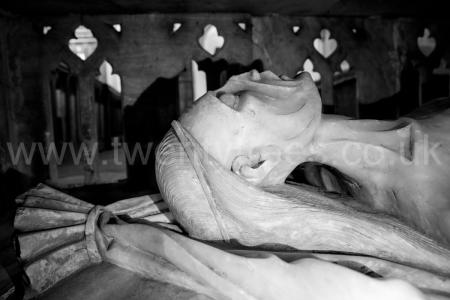
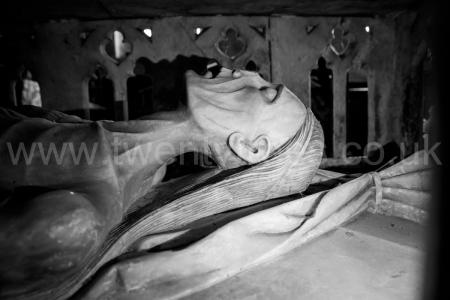
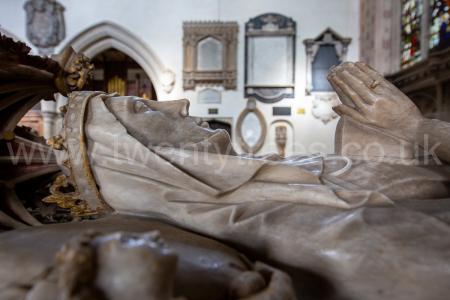
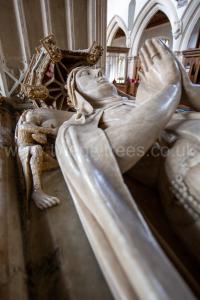
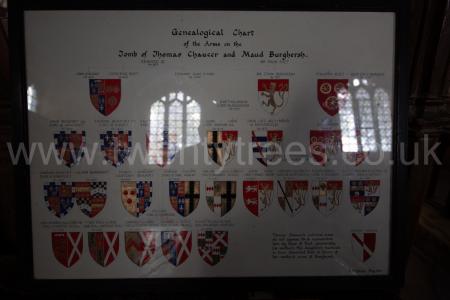
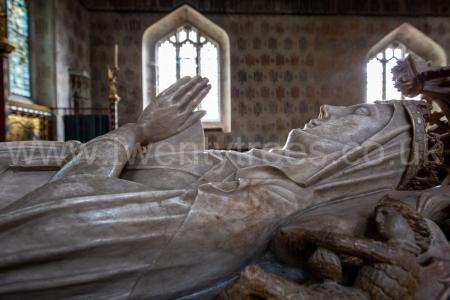
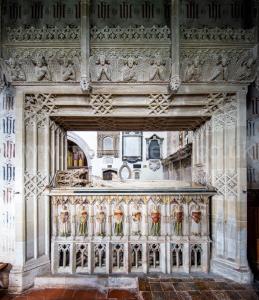
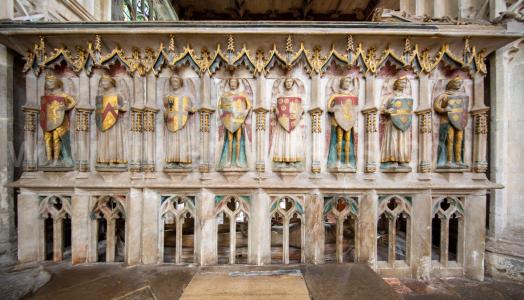
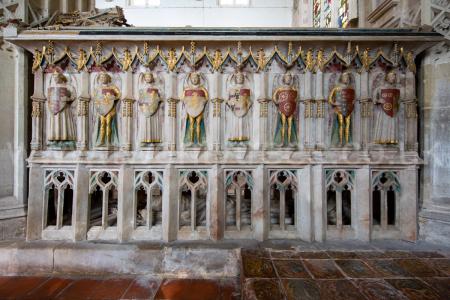
Chronicle of Jean de Wavrin 1429 Chapter VII. In these days, about Mid-Lent, after the regent was informed of the death of the good earl of Salisbury, and also that the besieged in Orléans had been reinforced with troops and artillery besides a great quantity of provisions, he, being then at Paris, took measures to have collected in Normandy and in the Isle of France from four to five hundred waggons and carts, which, by the diligence of some merchants, were loaded and all filled with various provisions and merchandizes, with plenty of artillery, to take to the English before the city of Orléans. When the said waggons and all these things were made ready, the whole was given into the charge and conduct of sir John Fastolf, who was very wise and prudent in arms, in whom the duke of Bedford the regent trusted greatly for he was his chief chamberlain and grand master of his household: with him were sent the provost of Paris named sir Simon Morhier, the bastard of Thyan a knight and bailly of Senlis, the provost of Melun and many other officers from about the Isle of France, accompanied by sixteen hmidred combatants and fully a thousand men of the common people, with whom the said Fastolf set out from the city of Paris at the beginning of Lent; and he conducted his men and baggage in good order for some days as far as a village called Rouvray-en-Beauce where he lodged; and this village is situated between Jenville and Orléans.

Kings Wessex: Great x 11 Grand Son of King Edmund "Ironside" I of England
Kings England: Great x 3 Grand Son of King Edward "Longshanks" I of England
Kings Scotland: Great x 9 Grand Son of Malcolm III King Scotland
Kings Franks: Great x 7 Grand Son of Louis VII King Franks
Kings France: Great x 8 Grand Son of Louis "Fat" VI King France
Anne Neville Queen Consort England x 1
Catherine Parr Queen Consort England x 1
Jane "Nine Days Queen" Grey I Queen England and Ireland x 1
Queen Elizabeth II of the United Kingdom x 38
Great x 4 Grandfather: William Montagu
Great x 3 Grandfather: Simon Montagu 1st Baron Montagu
Great x 2 Grandfather: William Montagu 2nd Baron Montagu
Great x 3 Grandmother: Hawise St Amand
Great x 1 Grandfather: William Montagu 1st Earl Salisbury 
Great x 4 Grandfather: Peter Montfort
Great x 3 Grandfather: Peter Montfort
Great x 4 Grandmother: Alice Audley
Great x 2 Grandmother: Elizabeth Montfort Baroness Furnivall Baroness Montagu
GrandFather: John Montagu 1st Baron Montagu, Baron Monthermer 
Great x 3 Grandfather: Pierre Grandison
Great x 2 Grandfather: William Grandison 1st Baron Grandison
Great x 1 Grandmother: Catherine Grandison Countess of Salisbury
Great x 2 Grandmother: Sibylla Tregoz Baroness Grandison
Father: John Montagu 3rd Earl Salisbury  2 x Great Grand Son of King Edward "Longshanks" I of England
2 x Great Grand Son of King Edward "Longshanks" I of England
Great x 2 Grandfather: Ralph Monthermer 1st Baron Monthermer
Great x 1 Grandfather: Thomas Monthermer 2nd Baron Monthermer  Grand Son of King Edward "Longshanks" I of England
Grand Son of King Edward "Longshanks" I of England
Great x 4 Grandfather: King Henry III of England Son of King John "Lackland" of England
Son of King John "Lackland" of England
Great x 3 Grandfather: King Edward "Longshanks" I of England Son of King Henry III of England
Son of King Henry III of England
Great x 4 Grandmother: Eleanor of Provence Queen Consort England
Great x 2 Grandmother: Joan of Acre Countess Gloucester and Hertford Daughter of King Edward "Longshanks" I of England
Daughter of King Edward "Longshanks" I of England
Great x 4 Grandfather: Ferdinand III King Castile III King Leon Great Grand Son of King Henry "Curtmantle" II of England
Great Grand Son of King Henry "Curtmantle" II of England
Great x 3 Grandmother: Eleanor of Castile Queen Consort England 2 x Great Grand Daughter of King Henry "Curtmantle" II of England
Great x 4 Grandmother: Joan Dammartin Queen Consort Castile and Leon
GrandMother: Margaret Monthermer Baroness Montagu 3rd Baroness Monthermer  Great Grand Daughter of King Edward "Longshanks" I of England
Great Grand Daughter of King Edward "Longshanks" I of England
Great x 2 Grandfather: Peter Brewes Count Flanders
Great x 1 Grandmother: Margaret Brewes Baroness Monthermer
Thomas Montagu 1st Count Perche 4th Earl Salisbury  3 x Great Grand Son of King Edward "Longshanks" I of England
3 x Great Grand Son of King Edward "Longshanks" I of England
GrandFather: Adam Francis